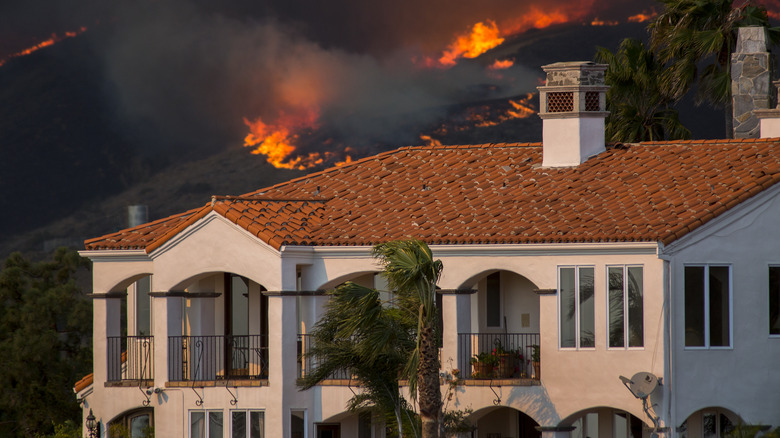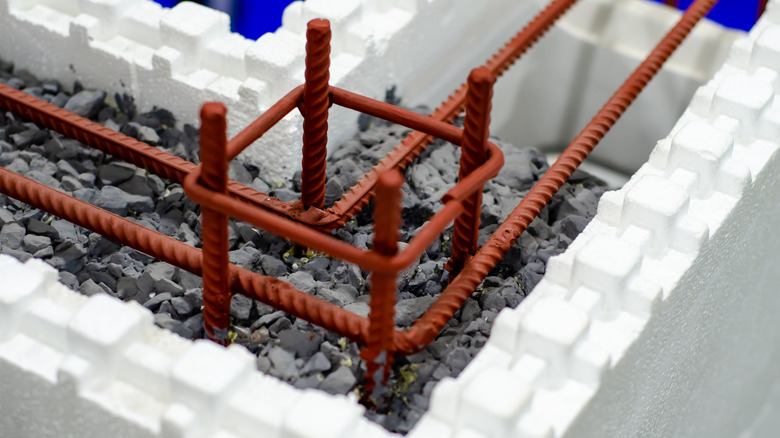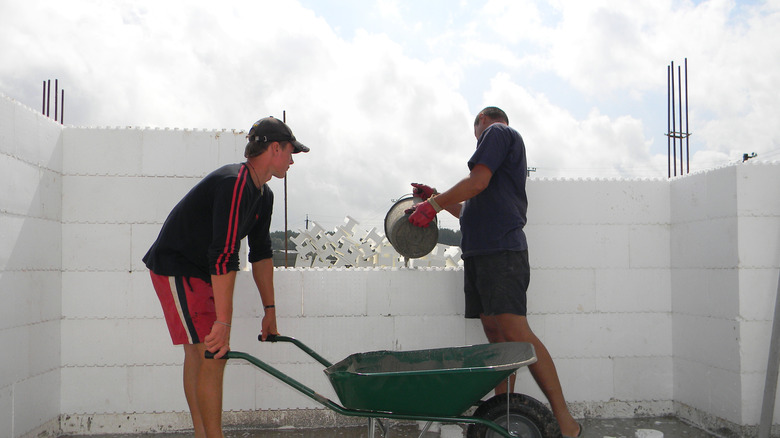One Easy But Crucial Way To Fireproof Your Home
The best way to fireproof a new home is to build it with fireproof bones. After the scenes of devastation that wildfires have wrought across the world in recent years, homebuilders in afflicted areas are turning to insulating concrete forms (ICF) to give enhanced protection to their structures. According to Green Constructors, ICF walls can be subjected to temperatures of 2300 degrees Farenhight for up to four hours and stay standing.
In addition, PCA notes that ICF forms are concrete walls that are cast in place, sandwiched between two layers of insulating foam. This foam is typically polystyrene and comes in light, easy-to-stack, and easy-to-cut bricks. Once the walls of insulation are constructed and appropriately braced, liquid concrete is poured into the gap between the layers, reinforced with rebar, and sets solid in place.
ICF walls are strong, well insulated, and modular, but they are also more expensive than other methods of building a house — are they worth it? What other properties does this apparently fire-resistant material have?
How fireproof is ICF?
You don't have to make your entire building from ICFs in order to benefit from their thermal properties. Per E-Architect, the initial phase of building any fire-resistant house is to make the foundations from ICFs. According to ABC7 News, homes that are built using ICF have been observed as survivors in neighborhoods devastated by wildfires. This has contributed to their increased popularity amongst housebuilders in fire-prone areas as risks increase.
All of the leading ICF brands showed no sign of weakening after 4-hour stress tests of continuous temperatures over 2000 degrees Farenhaight, per ICF Builder. This is a temperature range that's comparable to a wildfire. Along with the two layers of insulation, ICFs have 6 to 8 inches of non-flammable concrete, which itself is one of the best materials for trapping heat. This means that temperatures on the cool side of the wall stay low enough to avoid any combustion for 2 to 4 hours — which is much longer than a typical wall would take to collapse.
According to Checkatrade, in comparison to other building methods, ICF walls cost up to 20% more — however, if you are building in an area that is at significant risk of wildfires, those costs could be worth it to you.
Other things to consider about ICFs
So, we know ICF is a fire-resistant building material that goes up like lego bricks and costs slightly more to build a house with than a typical, run-of-the-mill new build. But as well as being fire-resistant, the insulated concrete layers of ICF do a great job at retaining winter heat within the house or keeping the heat of summer outside. This means a reduced need for heating and cooling via other means, and, according to Thermohouse, some new ICF homeowners have experienced up to a 60% reduction in their energy bills.
According to Green Garage, ICF construction takes less time, less concrete, and requires less insulation than traditional building methods — plus the solid nature of the insulated walls means better air quality and less noise pollution. Costs of labor, wood, and other materials associated with a traditional build have continually increased in recent years, not to mention energy bills. Although ICF construction may still cost a little more per square foot, the savings on labor during construction and the later saving on energy bills will more than compensate for the extra cost.
It isn't all green and rosy, though — ICFs are still made using fossil fuels, and while being more energy-efficient might be something you want to do for the planet, Treehugger maintains that sandwiches made from foam and concrete should not be on the menu for green buildings.



